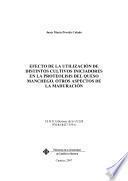Descargar Libro: Effect Of The Use Of Different Starter Cultures On The Proteolysis Of Manchego Cheese. Other Aspects Of The Ripening

Autores
Resumen del Libro
The aim of this work was to contribute to the knowledge of Manchego cheese ripening in order to improve its quality. The work was unstructured into three chapters: (1) improvement of the proposed model for the prediction of the ripening time of Manchego cheese, (2) study of lipolysis during Manchego cheese ripening and throughout the manufacturing season, and (3) the effect of the use of defined strain starter cultures and the addition of an adjunct culture (Lactobacillus plantarum) to cheesemilk in order to determine their effect on the ripening of Manchego cheese. The main results obtained were: (1) A statistic model was obtained for the prediction of the ripening time of Mancehgo cheeses. Partial Least Squares (PLS) regression was used to predict the ripening time of Manchego cheese, based on some physico-chemical parameters and secondary proteolysis indices of standard Manchego cheeses manufactured in different seasons. The variables that most contributed to predict the ripening time of the cheeses were water activity, pH and dry matter. The prediction model obtained yielded good results for the prediction of the ripening times of commercial Manchego cheeses, (2) The FFA profile of the Manchego cheese samples analysed was typical of ewes milk cheeses. The main fatty acids were palmitic and oleic. Lipolysis in the cheese samples was not very intense. The FFA that best correlated with ripening time were the shortchain fatty acids. Manchego cheeses manufactured in different seasons (spring, autumn and winter) were different according to the concentration of short chain FFAs, the amounts of these fatty acids being highest in winter cheeses and lowest in spring cheeses, (3) Principal component analysis of peak heights of reversed-phase HPLC chromatograms of 70% (v/v) ethanol-insoluble and -soluble fractions distributed the samples according to the starter used in their manufacture. Quantitative differences in several peptides were evident among the cheeses…